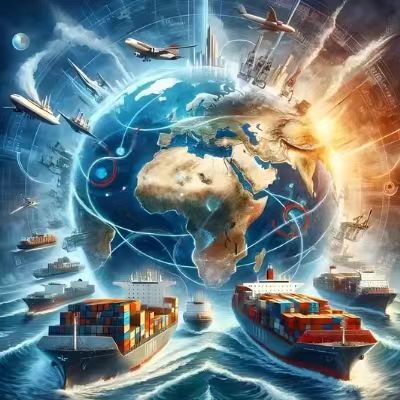
PHAgY2xhc3M9Ik1zb05vcm1hbCI+Cgk8Yj48c3Bhbj5BYnN0cmFjdDogJm5ic3A7PC9zcGFuPjwv
Yj48Yj48L2I+IAo8L3A+CjxwIGNsYXNzPSJNc29Ob3JtYWwiPgoJPHNwYW4+VGhlIFJlZCBTZWEg
c2hpcHBpbmcgY3Jpc2lzPC9zcGFuPjxzcGFuPuKAlDwvc3Bhbj48c3Bhbj50cmlnZ2VyZWQgYnkg
SG91dGhpIGF0dGFja3MgYW5kIHByb2xvbmdlZCBtYXJpdGltZSBkaXNydXB0aW9uczwvc3Bhbj48
c3Bhbj7igJQ8L3NwYW4+PHNwYW4+aGFzIHNsYXNoZWQgU3VleiBDYW5hbCB0cmFmZmljIGJ5IDUw
JSBhbmQgaW5mbGF0ZWQgQXNpYS1FdXJvcGUgb2NlYW4gZnJlaWdodCBjb3N0cyBieSAyMzMlPC9z
cGFuPjxzcGFuPuKAkzwvc3Bhbj48c3Bhbj4zMTAlIHNpbmNlIDIwMjMgLiBBcyBjYXJyaWVycyBy
ZXJvdXRlIHZpYSBBZnJpY2E8L3NwYW4+PHNwYW4+4oCZPC9zcGFuPjxzcGFuPnMgQ2FwZSBvZiBH
b29kIEhvcGUgKGFkZGluZyAxMjwvc3Bhbj48c3Bhbj7igJM8L3NwYW4+PHNwYW4+MjAgZGF5cyB0
cmFuc2l0IHRpbWUpLCBzdXBwbHkgY2hhaW5zIGZhY2Ugc2V2ZXJlIGRlbGF5cyBhbmQgJDgwQisg
aW4gc3RyYW5kZWQgY2FyZ28gLiBUaGUgQ2hpbmEtVHVya2V5IFJhaWwgQ29ycmlkb3IgZW1lcmdl
cyBhcyBhIHN0cmF0ZWdpYyBieXBhc3MsIG9mZmVyaW5nIGRvb3ItdG8tZG9vciBsb2dpc3RpY3Mg
d2l0aCB0cmFuc2l0IHRpbWVzIGFzIGxvdyBhcyAxMjwvc3Bhbj48c3Bhbj7igJM8L3NwYW4+PHNw
YW4+MTggZGF5czwvc3Bhbj48c3Bhbj7igJQ8L3NwYW4+PHNwYW4+MzA8L3NwYW4+PHNwYW4+4oCT
PC9zcGFuPjxzcGFuPjYwJSBmYXN0ZXIgdGhhbiBkaXZlcnRlZCBzZWEgcm91dGVzPC9zcGFuPjxz
cGFuPuKAlDwvc3Bhbj48c3Bhbj50aHJvdWdoIGludGVncmF0ZWQgcmFpbC1zZWEtYWlyIHNvbHV0
aW9ucy4gU3VwcG9ydGVkIGJ5IHJlYWwtdGltZSBDb3N0L1RpbWVyIFRvb2xzLCB0aGlzIGNvcnJp
ZG9yIGxldmVyYWdlcyBUdXJrZXk8L3NwYW4+PHNwYW4+4oCZPC9zcGFuPjxzcGFuPnMgRXVyYXNp
YW4gcmFpbCBodWIgc3RhdHVzIGFuZCBDaGluYTwvc3Bhbj48c3Bhbj7igJk8L3NwYW4+PHNwYW4+
cyAmIzM0O0JlbHQgYW5kIFJvYWQiIGluZnJhc3RydWN0dXJlIHRvIGN1dCBmcmVpZ2h0IGNvc3Rz
IGJ5IDE4PC9zcGFuPjxzcGFuPuKAkzwvc3Bhbj48c3Bhbj4yNSUgdmVyc3VzIGN1cnJlbnQgc2Vh
IHJhdGVzIHdoaWxlIGd1YXJhbnRlZWluZyByZWxpYWJpbGl0eS4gV2l0aCA0NTArIHNoaXBzIHN0
aWxsIGF2b2lkaW5nIHRoZSBSZWQgU2VhIGRlc3BpdGUgYSA2MCUgdHJhZmZpYyByZWJvdW5kICwg
dGhpcyByYWlsLWRyaXZlbiBtb2RlbCBpcyB0cmFuc2Zvcm1pbmcgY3Jpc2lzIHJlc3BvbnNlIGZv
ciBhdXRvbW90aXZlLCBzb2xhciwgYW5kIHJldGFpbCBzZWN0b3JzLiAmbmJzcDs8L3NwYW4+IAo8
L3A+CjxwIGNsYXNzPSJNc29Ob3JtYWwiPgoJJm5ic3A7CjwvcD4KPHAgY2xhc3M9Ik1zb05vcm1h
bCI+Cgk8Yj48c3Bhbj5LZXl3b3JkczogJm5ic3A7PC9zcGFuPjwvYj48Yj48L2I+IAo8L3A+Cjxw
IGNsYXNzPSJNc29Ob3JtYWwiPgoJPHNwYW4+Q2hpbmEtVHVya2V5IHJhaWwgZnJlaWdodCwgUmVk
IFNlYSBjcmlzaXMgc29sdXRpb24sIGRvb3ItdG8tZG9vciBsb2dpc3RpY3MgQXNpYS1FdXJvcGUs
IHJhaWwtc2VhIGludGVybW9kYWwsIENoaW5hLUV1cm9wZSBmcmVpZ2h0IHRyYWluLCBUdXJrZXkg
bG9naXN0aWNzIGh1YiwgZnJlaWdodCBjb3N0IGNhbGN1bGF0b3IsIHRyYW5zaXQgdGltZSB0b29s
LCBIb3V0aGkgYXR0YWNrIGFsdGVybmF0aXZlLCBzdXBwbHkgY2hhaW4gcmVzaWxpZW5jZSwgQmVs
dCBhbmQgUm9hZCBsb2dpc3RpY3MsIGNyb3NzLWJvcmRlciByYWlsIHNoaXBwaW5nLCBjb3N0LWVm
ZmVjdGl2ZSBmcmVpZ2h0LCBlbWVyZ2VuY3kgbG9naXN0aWNzLCBDaGluYSByYWlsIGV4cHJlc3Mg
Jm5ic3A7PC9zcGFuPiAKPC9wPgo8cCBjbGFzcz0iTXNvTm9ybWFsIj4KCSZuYnNwOwo8L3A+Cjxw
IGNsYXNzPSJNc29Ob3JtYWwiPgoJPHNwYW4+LS0tPC9zcGFuPiAKPC9wPgo8cCBjbGFzcz0iTXNv
Tm9ybWFsIj4KCSZuYnNwOwo8L3A+CjxwIGNsYXNzPSJNc29Ob3JtYWwiPgoJPGI+Jm5ic3A7PHNw
YW4+MS4gVGhlIFJlZCBTZWEgQ3Jpc2lzOiBBIExvZ2lzdGljcyBOaWdodG1hcmUgJm5ic3A7PC9z
cGFuPjwvYj48Yj48L2I+IAo8L3A+CjxwIGNsYXNzPSJNc29Ob3JtYWwiPgoJPHNwYW4+LSBUcmFm
ZmljIENvbGxhcHNlICZhbXA7IENvc3QgU3VyZ2U6IERhaWx5IHNoaXAgdHJhbnNpdHMgdGhyb3Vn
aCB0aGUgUmVkIFNlYSBwbHVtbWV0ZWQgZnJvbSA3Mjwvc3Bhbj48c3Bhbj7igJM8L3NwYW4+PHNw
YW4+NzUgcHJlLWNyaXNpcyB0byBqdXN0IDIwPC9zcGFuPjxzcGFuPuKAkzwvc3Bhbj48c3Bhbj4y
MyBieSBBdWd1c3QgMjAyNC4gQWx0aG91Z2ggdHJhZmZpYyByZWJvdW5kZWQgdG8gMzY8L3NwYW4+
PHNwYW4+4oCTPC9zcGFuPjxzcGFuPjM3IHNoaXBzL2RheSBieSBKdW5lIDIwMjUsIHZvbHVtZXMg
cmVtYWluIDUwJSBiZWxvdyBub3JtYWwgLiBDb25jdXJyZW50bHksIGZyZWlnaHQgcmF0ZXMgZnJv
bSBTaGFuZ2hhaSB0byBSb3R0ZXJkYW0gZXhwbG9kZWQgZnJvbSAkMSw4MDAgdG8gJDYsMDAwKy9j
b250YWluZXI8L3NwYW4+PHNwYW4+4oCUPC9zcGFuPjxzcGFuPmEgMjMzJSBoaWtlIC4gJm5ic3A7
PC9zcGFuPiAKPC9wPgo8cCBjbGFzcz0iTXNvTm9ybWFsIj4KCTxzcGFuPi0gT3BlcmF0aW9uYWwg
Q2hhb3M6IFRoZSBIb3V0aGktdGFyZ2V0ZWQgZGl2ZXJzaW9uIHZpYSB0aGUgQ2FwZSBvZiBHb29k
IEhvcGUgYWRkcyA2LDAwMCBuYXV0aWNhbCBtaWxlcyBhbmQgMTI8L3NwYW4+PHNwYW4+4oCTPC9z
cGFuPjxzcGFuPjIwIGRheXMgdG8gdm95YWdlcywgc3RyYW5kaW5nICQ4MEIrIGNhcmdvIGFuZCBz
cGlraW5nIGluc3VyYW5jZSBjb3N0cyB0byAwLjUlIG9mIHZlc3NlbCB2YWx1ZSAodnMuIDAuMSUg
cHJlLWNyaXNpcykgLiAmbmJzcDs8L3NwYW4+IAo8L3A+CjxwIGNsYXNzPSJNc29Ob3JtYWwiPgoJ
PHNwYW4+LSBFbnZpcm9ubWVudGFsIFRvbGw6IExvbmdlciBzZWEgcm91dGVzIGluY3JlYXNlZCBm
dWVsIGNvbnN1bXB0aW9uIGFuZCBjYXJib24gZW1pc3Npb25zIGJ5IDI2MCU8L3NwYW4+PHNwYW4+
4oCTPC9zcGFuPjxzcGFuPjM1NCUsIHVuZGVybWluaW5nIGdsb2JhbCBkZWNhcmJvbml6YXRpb24g
Z29hbHMgLiAmbmJzcDs8L3NwYW4+IAo8L3A+CjxwIGNsYXNzPSJNc29Ob3JtYWwiPgoJPGI+Jm5i
c3A7PC9iPiAKPC9wPgo8cCBjbGFzcz0iTXNvTm9ybWFsIj4KCTxiPiZuYnNwOzxzcGFuPjIuIENo
aW5hLVR1cmtleSBSYWlsOiBUaGUgRG9vci10by1Eb29yIFNvbHV0aW9uICZuYnNwOzwvc3Bhbj48
L2I+PGI+PC9iPiAKPC9wPgo8cCBjbGFzcz0iTXNvTm9ybWFsIj4KCTxzcGFuPlR1cmtleTwvc3Bh
bj48c3Bhbj7igJk8L3NwYW4+PHNwYW4+cyBnZW9ncmFwaGljIGFuZCBpbmZyYXN0cnVjdHVyYWwg
cG9zaXRpb248L3NwYW4+PHNwYW4+4oCUPC9zcGFuPjxzcGFuPmJyaWRnaW5nIEFzaWEgYW5kIEV1
cm9wZSB2aWEgdGhlIE1pZGRsZSBDb3JyaWRvcjwvc3Bhbj48c3Bhbj7igJQ8L3NwYW4+PHNwYW4+
ZW5hYmxlcyBzZWFtbGVzcyByYWlsLWxlZCBsb2dpc3RpY3M6ICZuYnNwOzwvc3Bhbj4gCjwvcD4K
PHAgY2xhc3M9Ik1zb05vcm1hbCI+Cgk8c3Bhbj4tIENvcmUgUm91dGU6ICZuYnNwOzwvc3Bhbj4g
CjwvcD4KPHAgY2xhc3M9Ik1zb05vcm1hbCI+CgkmbmJzcDsmbmJzcDs8c3Bhbj5DaGluYSA8L3Nw
YW4+PHNwYW4+4oaSIDwvc3Bhbj48c3Bhbj5LYXpha2hzdGFuIDwvc3Bhbj48c3Bhbj7ihpIgPC9z
cGFuPjxzcGFuPkNhc3BpYW4gU2VhIChBemVyYmFpamFuKSA8L3NwYW4+PHNwYW4+4oaSIDwvc3Bh
bj48c3Bhbj5HZW9yZ2lhIDwvc3Bhbj48c3Bhbj7ihpIgPC9zcGFuPjxzcGFuPlR1cmtleSA8L3Nw
YW4+PHNwYW4+4oaSIDwvc3Bhbj48c3Bhbj5FdXJvcGUgJm5ic3A7PC9zcGFuPiAKPC9wPgo8cCBj
bGFzcz0iTXNvTm9ybWFsIj4KCTxzcGFuPi0gSW50ZWdyYXRlZCBNb2RhbHM6ICZuYnNwOzwvc3Bh
bj4gCjwvcD4KPHAgY2xhc3M9Ik1zb05vcm1hbCI+CgkmbmJzcDsmbmJzcDs8c3Bhbj4tIFJhaWw6
IEhpZ2gtZnJlcXVlbmN5IENoaW5hLUV1cm9wZSBmcmVpZ2h0IHRyYWlucyAoOCw1MDArIGN1bXVs
YXRpdmUgdHJpcHMpIC4gJm5ic3A7PC9zcGFuPiAKPC9wPgo8cCBjbGFzcz0iTXNvTm9ybWFsIj4K
CSZuYnNwOyZuYnNwOzxzcGFuPi0gU2VhOiBTaG9ydC1zZWEgc2hpcHBpbmcgYWNyb3NzIHRoZSBD
YXNwaWFuL0JsYWNrIFNlYXMuICZuYnNwOzwvc3Bhbj4gCjwvcD4KPHAgY2xhc3M9Ik1zb05vcm1h
bCI+CgkmbmJzcDsmbmJzcDs8c3Bhbj4tIEFpcjogTGFzdC1taWxlIGFpciBjYXJnbyBmcm9tIElz
dGFuYnVsIHRvIEVVIGh1YnMuICZuYnNwOzwvc3Bhbj4gCjwvcD4KPHAgY2xhc3M9Ik1zb05vcm1h
bCI+CgkmbmJzcDsKPC9wPgo8cCBjbGFzcz0iTXNvTm9ybWFsIj4KCSZuYnNwOzxzcGFuPuKcqCA8
L3NwYW4+PHNwYW4+S2V5IEFkdmFudGFnZXMgdnMuIFNlYSBGcmVpZ2h0OiAmbmJzcDs8L3NwYW4+
IAo8L3A+CjxwIGNsYXNzPSJNc29Ob3JtYWwiPgoJPHNwYW4+fCBNZXRyaWMgJm5ic3A7Jm5ic3A7
Jm5ic3A7Jm5ic3A7Jm5ic3A7Jm5ic3A7Jm5ic3A7Jm5ic3A7Jm5ic3A7fCBEaXZlcnRlZCBTZWEg
Um91dGUgJm5ic3A7Jm5ic3A7Jm5ic3A7Jm5ic3A7Jm5ic3A7Jm5ic3A7fCBDaGluYS1UdXJrZXkg
UmFpbCAmbmJzcDsmbmJzcDsmbmJzcDsmbmJzcDsmbmJzcDsmbmJzcDsmbmJzcDt8ICZuYnNwOzwv
c3Bhbj4gCjwvcD4KPHAgY2xhc3M9Ik1zb05vcm1hbCI+Cgk8c3Bhbj58LS0tLS0tLS0tLS0tLS0t
LS0tLS0tLXwtLS0tLS0tLS0tLS0tLS0tLS0tLS0tLS0tLXwtLS0tLS0tLS0tLS0tLS0tLS0tLS0t
LS0tLXwgJm5ic3A7PC9zcGFuPiAKPC9wPgo8cCBjbGFzcz0iTXNvTm9ybWFsIj4KCTxzcGFuPnwg
VHJhbnNpdCBUaW1lICZuYnNwOyZuYnNwOyZuYnNwOyZuYnNwO3wgMzU8L3NwYW4+PHNwYW4+4oCT
PC9zcGFuPjxzcGFuPjQ1IGRheXMgJm5ic3A7Jm5ic3A7Jm5ic3A7Jm5ic3A7Jm5ic3A7Jm5ic3A7
Jm5ic3A7Jm5ic3A7Jm5ic3A7Jm5ic3A7Jm5ic3A7Jm5ic3A7Jm5ic3A7Jm5ic3A7fCAxMjwvc3Bh
bj48c3Bhbj7igJM8L3NwYW4+PHNwYW4+MTggZGF5cyAmbmJzcDsmbmJzcDsmbmJzcDsmbmJzcDsm
bmJzcDsmbmJzcDsmbmJzcDsmbmJzcDsmbmJzcDsmbmJzcDt8ICZuYnNwOzwvc3Bhbj4gCjwvcD4K
PHAgY2xhc3M9Ik1zb05vcm1hbCI+Cgk8c3Bhbj58IENvc3QgKFNoYW5naGFpPC9zcGFuPjxzcGFu
PuKGkjwvc3Bhbj48c3Bhbj5FVSl8ICQ1LDAwMDwvc3Bhbj48c3Bhbj7igJM8L3NwYW4+PHNwYW4+
JDYsMjAwL2NvbnRhaW5lciB8ICQ0LDEwMDwvc3Bhbj48c3Bhbj7igJM8L3NwYW4+PHNwYW4+JDQs
OTAwICZuYnNwOyZuYnNwOyZuYnNwOyZuYnNwOyZuYnNwOyZuYnNwO3wgJm5ic3A7PC9zcGFuPiAK
PC9wPgo8cCBjbGFzcz0iTXNvTm9ybWFsIj4KCTxzcGFuPnwgUmVsaWFiaWxpdHkgJm5ic3A7Jm5i
c3A7Jm5ic3A7Jm5ic3A7Jm5ic3A7fCA0MCUgc2NoZWR1bGUgdmFyaWFuY2UgJm5ic3A7Jm5ic3A7
Jm5ic3A7fCA5NSUgb24tdGltZSByYXRlICZuYnNwOyZuYnNwOyZuYnNwOyZuYnNwO3wgJm5ic3A7
PC9zcGFuPiAKPC9wPgo8cCBjbGFzcz0iTXNvTm9ybWFsIj4KCTxzcGFuPnwgQ088L3NwYW4+PHNw
YW4+4oKCIDwvc3Bhbj48c3Bhbj5FbWlzc2lvbnMgJm5ic3A7Jm5ic3A7Jm5ic3A7fCB+Mi4xIHRv
bnMvY29udGFpbmVyICZuYnNwOyZuYnNwOyZuYnNwOyZuYnNwOyZuYnNwO3wgfjAuNyB0b25zICgt
NjclKSAmbmJzcDsmbmJzcDsmbmJzcDsmbmJzcDt8ICZuYnNwOzwvc3Bhbj4gCjwvcD4KPHAgY2xh
c3M9Ik1zb05vcm1hbCI+CgkmbmJzcDsKPC9wPgo8cCBjbGFzcz0iTXNvTm9ybWFsIj4KCTxzdHJv
bmc+Jm5ic3A7PC9zdHJvbmc+PHNwYW4+PHN0cm9uZz4zLiBEb29yLXRvLURvb3IgU2VydmljZSBB
cmNoaXRlY3R1cmUgJm5ic3A7PC9zdHJvbmc+PC9zcGFuPiAKPC9wPgo8cCBjbGFzcz0iTXNvTm9y
bWFsIj4KCSZuYnNwOzxzcGFuPkEuIFNtYXJ0IEJvb2tpbmcgJmFtcDsgUmVhbC1UaW1lIFRyYWNr
aW5nICZuYnNwOzwvc3Bhbj4gCjwvcD4KPHAgY2xhc3M9Ik1zb05vcm1hbCI+Cgk8c3Bhbj4tIENv
c3QvVGltZXIgVG9vbDogQWxnb3JpdGhtcyBkeW5hbWljYWxseSBjYWxjdWxhdGUgcmF0ZXMvdHJh
bnNpdHMgYmFzZWQgb24gY2FyZ28gdHlwZSwgdm9sdW1lLCBhbmQgdXJnZW5jeS4gVXNlcnMgaW5w
dXQgb3JpZ2luIChlLmcuLCBYaTwvc3Bhbj48c3Bhbj7igJk8L3NwYW4+PHNwYW4+YW4pLCBkZXN0
aW5hdGlvbiAoZS5nLiwgRnJhbmtmdXJ0KSwgYW5kIGxvYWQgc3BlY3MgdG8gcmVjZWl2ZSBvcHRp
bWl6ZWQgcmFpbC1zZWEtYWlyIHJvdXRpbmcgd2l0aCBjb3N0L3NjaGVkdWxlIGJyZWFrZG93bnMu
ICZuYnNwOzwvc3Bhbj4gCjwvcD4KPHAgY2xhc3M9Ik1zb05vcm1hbCI+Cgk8c3Bhbj4tIExpdmUg
TW9uaXRvcmluZzogR1BTLWVuYWJsZWQgY29udGFpbmVyIHRyYWNraW5nIGFjcm9zcyByYWlsIHRy
YW5zZmVycyBhbmQgYm9yZGVyIGNyb3NzaW5ncyAoZS5nLiwgSG9yZ29zL0tob3Jnb3MpLiAmbmJz
cDs8L3NwYW4+IAo8L3A+CjxwIGNsYXNzPSJNc29Ob3JtYWwiPgoJJm5ic3A7CjwvcD4KPHAgY2xh
c3M9Ik1zb05vcm1hbCI+CgkmbmJzcDs8c3Bhbj5CLiBUdXJrZXk8L3NwYW4+PHNwYW4+4oCZPC9z
cGFuPjxzcGFuPnMgSHViIFN5bmVyZ3kgJm5ic3A7PC9zcGFuPiAKPC9wPgo8cCBjbGFzcz0iTXNv
Tm9ybWFsIj4KCTxzcGFuPi0gSXN0YW5idWw8L3NwYW4+PHNwYW4+4oCZPC9zcGFuPjxzcGFuPnMg
Um9sZTogQ29uc29saWRhdGVzIGNhcmdvIGZyb20gQ2VudHJhbCBBc2lhL0NoaW5hIGZvciBFVSBk
aXN0cmlidXRpb24gdmlhOiAmbmJzcDs8L3NwYW4+IAo8L3A+CjxwIGNsYXNzPSJNc29Ob3JtYWwi
PgoJJm5ic3A7Jm5ic3A7PHNwYW4+LSBSYWlsOiBEaXJlY3QgbGlua3MgdG8gU29maWEvQnVkYXBl
c3QuICZuYnNwOzwvc3Bhbj4gCjwvcD4KPHAgY2xhc3M9Ik1zb05vcm1hbCI+CgkmbmJzcDsmbmJz
cDs8c3Bhbj4tIEFpcjogVHVya2lzaCBBaXJsaW5lcyBjYXJnbyBmbGlnaHRzIHRvIDEyMCsgY2l0
aWVzLiAmbmJzcDs8L3NwYW4+IAo8L3A+CjxwIGNsYXNzPSJNc29Ob3JtYWwiPgoJJm5ic3A7Jm5i
c3A7PHNwYW4+LSBUcnVja2luZzogUGFsbGV0aXplZCBsYXN0LW1pbGUgZGVsaXZlcnkuICZuYnNw
Ozwvc3Bhbj4gCjwvcD4KPHAgY2xhc3M9Ik1zb05vcm1hbCI+Cgk8c3Bhbj4tIEN1c3RvbXMgSW5u
b3ZhdGlvbjogU2luZ2xlIGVsZWN0cm9uaWMgZGVjbGFyYXRpb24gZm9yIENoaW5hPC9zcGFuPjxz
cGFuPuKGkjwvc3Bhbj48c3Bhbj5UdXJrZXk8L3NwYW4+PHNwYW4+4oaSPC9zcGFuPjxzcGFuPkVV
IHNoaXBtZW50cywgc2xhc2hpbmcgY2xlYXJhbmNlIGZyb20gNDggaHJzIHRvIDYgaHJzIC4gJm5i
c3A7PC9zcGFuPiAKPC9wPgo8cCBjbGFzcz0iTXNvTm9ybWFsIj4KCSZuYnNwOwo8L3A+CjxwIGNs
YXNzPSJNc29Ob3JtYWwiPgoJJm5ic3A7PHNwYW4+Qy4gRW5kLXRvLUVuZCBQYXJ0bmVycyAmbmJz
cDs8L3NwYW4+IAo8L3A+CjxwIGNsYXNzPSJNc29Ob3JtYWwiPgoJPHNwYW4+LSBSYWlsOiBDUiBF
eHByZXNzLCBVVElLIExvZ2lzdGljcy4gJm5ic3A7PC9zcGFuPiAKPC9wPgo8cCBjbGFzcz0iTXNv
Tm9ybWFsIj4KCTxzcGFuPi0gUG9ydHM6IEJha3UgKEF6ZXJiYWlqYW4pLCBQb3RpIChHZW9yZ2lh
KS4gJm5ic3A7PC9zcGFuPiAKPC9wPgo8cCBjbGFzcz0iTXNvTm9ybWFsIj4KCTxzcGFuPi0gTGFz
dCBNaWxlOiBESEwsIERCIFNjaGVua2VyLiAmbmJzcDs8L3NwYW4+IAo8L3A+CjxwIGNsYXNzPSJN
c29Ob3JtYWwiPgoJPGI+Jm5ic3A7PC9iPiAKPC9wPgo8cCBjbGFzcz0iTXNvTm9ybWFsIj4KCTxi
PiZuYnNwOzxzcGFuPjQuIEluZHVzdHJ5IEFwcGxpY2F0aW9uczogQ3Jpc2lzLVByb29maW5nIFN1
cHBseSBDaGFpbnMgPC9zcGFuPjwvYj4mbmJzcDsKPC9wPgo8cCBjbGFzcz0iTXNvTm9ybWFsIj4K
CTxzcGFuPi0gQXV0b21vdGl2ZTogSnVzdC1pbi10aW1lIHBhcnRzIGRlbGl2ZXJ5IGZvciBFVSBm
YWN0b3JpZXMgKGUuZy4sIEJNVy9NZXJjZWRlcykgYXZvaWRpbmcgYXNzZW1ibHkgbGluZSBoYWx0
cy4gQ29zdCBzYXZpbmdzOiAyMiUgdnMuIGFpciBmcmVpZ2h0LiAmbmJzcDs8L3NwYW4+IAo8L3A+
CjxwIGNsYXNzPSJNc29Ob3JtYWwiPgoJPHNwYW4+LSBTb2xhciBFbmVyZ3k6IENyaXRpY2FsIGZv
ciBwYW5lbHMvdGltZS1zZW5zaXRpdmUgaW52ZXJ0ZXJzIGZhY2luZyBFVSBzdWJzaWR5IGRlYWRs
aW5lcy4gVHJhbnNpdCByZWxpYWJpbGl0eTogOTglIHZzLiBzZWE8L3NwYW4+PHNwYW4+4oCZPC9z
cGFuPjxzcGFuPnMgNjQlIC4gJm5ic3A7PC9zcGFuPiAKPC9wPgo8cCBjbGFzcz0iTXNvTm9ybWFs
Ij4KCTxzcGFuPi0gUmV0YWlsL0UtY29tbWVyY2U6IEZhc3QtcmVwbGVuaXNobWVudCBjeWNsZXMg
Zm9yIFphcmEvQW1hem9uOyAxOC1kYXkgZG9vci10by1kb29yIGZyb20gR3Vhbmd6aG91IHRvIFBh
cmlzLiAmbmJzcDs8L3NwYW4+IAo8L3A+CjxwIGNsYXNzPSJNc29Ob3JtYWwiPgoJJm5ic3A7Cjwv
cD4KPHAgY2xhc3M9Ik1zb05vcm1hbCI+CgkmbmJzcDs8Yj48c3Bhbj41LiBJbXBsZW1lbnRpbmcg
UmFpbCBMb2dpc3RpY3M6IEEgNC1TdGVwIEd1aWRlICZuYnNwOzwvc3Bhbj48L2I+IAo8L3A+Cjxw
IGNsYXNzPSJNc29Ob3JtYWwiPgoJPHNwYW4+MS4gQXVkaXQgU2hpcG1lbnRzOiBQcmlvcml0aXpl
IGhpZ2gtdmFsdWUsIHVyZ2VudCwgb3IgcGVyaXNoYWJsZSBnb29kcyAoZS5nLiwgZWxlY3Ryb25p
Y3MsIGZhc2hpb24pLiAmbmJzcDs8L3NwYW4+IAo8L3A+CjxwIGNsYXNzPSJNc29Ob3JtYWwiPgoJ
PHNwYW4+Mi4gTGV2ZXJhZ2UgdGhlIENvc3QvVGltZXIgVG9vbDogTW9kZWwgc2NlbmFyaW9zIChl
LmcuLCByYWlsLW9ubHkgdnMuIHJhaWwtYWlyIGh5YnJpZCkgYXQgdG9vbHMuZmFzdGVuem9uZS5j
b20vcmVkc2VhLWJ5cGFzcy4gJm5ic3A7PC9zcGFuPiAKPC9wPgo8cCBjbGFzcz0iTXNvTm9ybWFs
Ij4KCTxzcGFuPjMuIFByZS1DbGVhciBEb2N1bWVudGF0aW9uOiBTdWJtaXQgSFMgY29kZXMvQ0Ug
Y2VydGlmaWNhdGVzIGRpZ2l0YWxseSB0byBUdXJraXNoIGN1c3RvbXMuICZuYnNwOzwvc3Bhbj4g
CjwvcD4KPHAgY2xhc3M9Ik1zb05vcm1hbCI+Cgk8c3Bhbj40LiBNb25pdG9yICZhbXA7IE9wdGlt
aXplOiBVc2UgbGl2ZSBkYXNoYm9hcmRzIHRvIHJlcm91dGUgYXJvdW5kIGJvdHRsZW5lY2tzIChl
LmcuLCBDYXNwaWFuIFNlYSB3ZWF0aGVyIGRlbGF5cykuICZuYnNwOzwvc3Bhbj4gCjwvcD4KPHAg
Y2xhc3M9Ik1zb05vcm1hbCI+CgkmbmJzcDsKPC9wPgo8cCBjbGFzcz0iTXNvTm9ybWFsIj4KCTxi
PiZuYnNwOzxzcGFuPjYuIFRoZSBGdXR1cmU6IFJhaWw8L3NwYW4+PHNwYW4+4oCZPC9zcGFuPjxz
cGFuPnMgQXNjZW5kYW5jZSBpbiBHbG9iYWwgVHJhZGUgJm5ic3A7PC9zcGFuPjwvYj48Yj48L2I+
IAo8L3A+CjxwIGNsYXNzPSJNc29Ob3JtYWwiPgoJPHNwYW4+LSBDYXBhY2l0eSBFeHBhbnNpb246
IENoaW5hIHBsYW5zIDEwIG5ldyByYWlsIGxpbmtzIHRvIFR1cmtleSBieSAyMDI3LCBjdXR0aW5n
IHRyYW5zaXQgdGltZXMgdG8gMTA8L3NwYW4+PHNwYW4+4oCTPC9zcGFuPjxzcGFuPjE0IGRheXMu
ICZuYnNwOzwvc3Bhbj4gCjwvcD4KPHAgY2xhc3M9Ik1zb05vcm1hbCI+Cgk8c3Bhbj4tIFN1c3Rh
aW5hYmlsaXR5IEVkZ2U6IFJhaWwgZW1pdHMgNjclIGxlc3MgQ088L3NwYW4+PHNwYW4+4oKCIDwv
c3Bhbj48c3Bhbj50aGFuIGRpdmVydGVkIHNoaXBwaW5nPC9zcGFuPjxzcGFuPuKAlDwvc3Bhbj48
c3Bhbj5hbGlnbmluZyB3aXRoIEVVIENhcmJvbiBCb3JkZXIgVGF4IChDQkFNKSBjb21wbGlhbmNl
IC4gJm5ic3A7PC9zcGFuPiAKPC9wPgo8cCBjbGFzcz0iTXNvTm9ybWFsIj4KCTxzcGFuPi0gR2Vv
cG9saXRpY2FsIFNoaWVsZDogSW1tdW5lIHRvIG1hcml0aW1lIGNob2tlcG9pbnRzIChIb3JtdXos
IE1hbGFjY2EpIGFuZCBSZWQgU2VhIHZvbGF0aWxpdHkgLiAmbmJzcDs8L3NwYW4+IAo8L3A+Cjxw
IGNsYXNzPSJNc29Ob3JtYWwiPgoJJm5ic3A7CjwvcD4KPHAgY2xhc3M9Ik1zb05vcm1hbCI+Cgk8
c3Bhbj4mZ3Q7ICYjMzQ7VGhlIENoaW5hLVR1cmtleSBjb3JyaWRvciBpc248L3NwYW4+PHNwYW4+
4oCZPC9zcGFuPjxzcGFuPnQganVzdCBhIHdvcmthcm91bmQ8L3NwYW4+PHNwYW4+4oCUPC9zcGFu
PjxzcGFuPml0PC9zcGFuPjxzcGFuPuKAmTwvc3Bhbj48c3Bhbj5zIGEgcmVlbmdpbmVlcmluZyBv
ZiB0cmFkZSByZXNpbGllbmNlLiBGb3IgZXZlcnkgJDFNIHNoaXBtZW50LCBjbGllbnRzIHNhdmUg
JDE4MEsgYW5kIDE0IGRheXMgdmVyc3VzIHRvZGF5PC9zcGFuPjxzcGFuPuKAmTwvc3Bhbj48c3Bh
bj5zIG9jZWFuIGNoYW9zLiIgPC9zcGFuPiAKPC9wPgo8cCBjbGFzcz0iTXNvTm9ybWFsIj4KCSZu
YnNwOwo8L3A+
